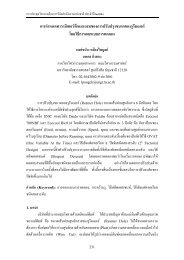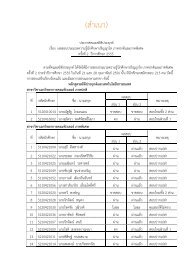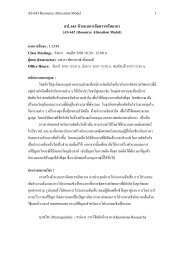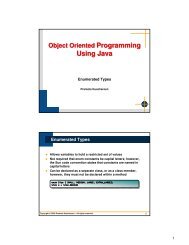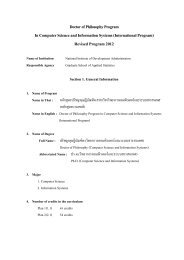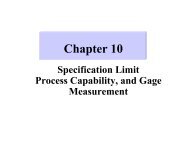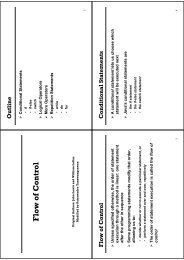ดาวน์โหลด All Proceeding - AS Nida
ดาวน์โหลด All Proceeding - AS Nida
ดาวน์โหลด All Proceeding - AS Nida
You also want an ePaper? Increase the reach of your titles
YUMPU automatically turns print PDFs into web optimized ePapers that Google loves.
Figure 3. Random interval 0-1 for each job operation.<br />
Figure 4. Sort random number and follow with job operation.<br />
Figure 5. Check and repair the sequence of each job.<br />
3.2 Firefly evaluation<br />
The next stage is to measure the flashing light intensity of<br />
the firefly, which depends on the problem considered. In this work, the<br />
evaluation on the goodness of schedules is measured by the makespan,<br />
which can be calculated using equation (1), where Ck is completed time<br />
of job k.<br />
Minimises: Cmax = max(<br />
C1,<br />
C2,<br />
K,<br />
Ck<br />
)<br />
(1)<br />
3.3 Distance<br />
The distance between any two fireflies i and j at xi and xj, respectively, can be defined as a Cartesian distance (rij) using equation<br />
(2), where xi,k is the k th component of the spatial coordinate xi of the i th<br />
firefly and d is the number of dimensions [9, 23].<br />
( ) 2<br />
d<br />
r = x − x || = x − x<br />
(2)<br />
ij<br />
|| i j ∑ k = 1<br />
3.4 Attractiveness<br />
The calculation of attractiveness function of a firefly are<br />
shown in equations (3), where r is the distance between any two<br />
fireflies, β0 is the initial attractiveness at r = 0, and γ is an absorption<br />
coefficient which controls the decrease of the light intensity [9, 23].<br />
m<br />
β = β × exp(<br />
−γr<br />
), with m ≥ 1<br />
(3)<br />
( r )<br />
0<br />
3.5 Movement<br />
The movement of a firefly i which is attracted by a more<br />
attractive (i.e., brighter) firefly j is given by the following equation (4),<br />
i,<br />
k<br />
j,<br />
k<br />
93<br />
where xi is the current position or solution of a firefly,<br />
2<br />
the β0 × exp( −γrij<br />
) × ( x j − xi<br />
) is attractiveness of a firefly to seen by<br />
adjacent fireflies. The α(rand – 1/2) is a firefly’s random movement.<br />
The coefficient α is a randomisation parameter determined by the<br />
problem of interest with α [0, 1], while rand is a random number<br />
obtained from the uniform distribution in the space [0, 1] [9, 23].<br />
2<br />
1<br />
= x + β × exp(<br />
−γr<br />
) × ( x − x ) + α(<br />
rand − ) (4)<br />
xi i 0<br />
ij j i<br />
Since the FA was recently developed, there have been a few<br />
research works applied the FA for solving optimisation problems, most<br />
of which has been formulated into mathematical equations. In the<br />
previous works, the settings of FA parameters, including the amount of<br />
fireflies (n), the number of generations (G), the light absorption<br />
coefficient (γ), the randomisation parameter (α) and the attractiveness<br />
value (β 0), have been defined in an ad hoc fashion. Table 3 summarises<br />
the FA parameter settings used in previous researches for solving<br />
various optimisation problems. Unfortunately, most of the work has not<br />
reported on the investigation of the appropriate setting of FA parameters<br />
via a proper statistical design and analysis. The computational<br />
experiments described in the next section were therefore proposed to<br />
identify the appropriate setting of FA parameters for solving scheduling<br />
problem.<br />
Table 3. Examples of FA parameters’ setting used in previous<br />
researches.<br />
Authors Problems<br />
nG<br />
FA parameters<br />
γ α β0 Apostolopoulos<br />
and Vlachos [24]<br />
Economic<br />
emissions load<br />
dispatch<br />
12*50 1.0 0.2 1.0<br />
Lukasik and Zak<br />
[10]<br />
Continuous<br />
equation<br />
40*250 1.0 0.01 1.0<br />
Horng and Jiang<br />
[25]<br />
Image vector<br />
quantisation<br />
50*200 1.0 0.01 1.0<br />
4. Experimental Design and Analysis<br />
In this research, the computational experiments were<br />
sequentially designed into two steps: identify the appropriate setting of<br />
the FA parameters and compare the results obtained from FA using the<br />
best setting identified in the previous experiment with two other results:<br />
i) adopting different parameter settings used by other research; and ii)<br />
the Best Known Solutions (BKS) from the literature [26]. Due to the<br />
2




